ABSTRACT
The introduction of the paper describes aspects related to climate change, the SDGs, sustainability, and also how the RACHP sector will be dealt with. The efforts to achieve carbon neutrality or net zero by 2050, the pros and cons of various elements, the sustainability of approaches, and the current status towards such net zero scenario are assessed. The focus is then on the RACHP sector, where major issues such as managing the refrigeration demand, optimizing energy efficiency as well as good practices score highest. An extensive assessment is made of several important, literature-based approaches how to best address the net zero ‘RACHP challenge’, from which a preliminary priority list is put together for (strategic) actions to be considered. Further analysis is presented which qualitative pathways could be followed to gradually decrease RACHP-related emissions to reach compliance with a 2050 net zero target. Finally, a number of important conclusions are presented as to the ways forward for net zero in a broad framework and specifically for RACHP as of immediately.
*This paper is based on a paper contribution to the DKV (German Refrigeration Society) Annual Meeting 2021 (Kuijpers et al., 2021), where certain parts have been changed, and relevant text has been added and/or updated.
Keywords: Circular economy, energy efficiency, low-GWP refrigerants, net zero, pathways to net zero, RACHP, renewable energy, sustainability.
INTRODUCTION
Climate change is being caused by numerous ever-growing effects and impacts from a human based earth system that will cost time to stabilize, where the atmospheric stabilization will be a grand and also multi-faced, immense operation. This will include a mix of nature restoration, adequate human behavior and the application of sound, existing and new technologies at the right moment. “The world is confronting a complex set of interwoven challenges; unless you tackle them together, you are not going to do very well on any of them.” (IPCC, 2021a).
In the 19th century, carbon dioxide (CO2) was produced through various processes across the world and absorbed by plants and oceans and via several other mechanisms. In principle, this was a zero-carbon society. At present, the burning of coal, oil and natural gas far outstrips what plants and oceans can remove from the air, which has led to a continuous increase of CO2 concentrations since the start of the industrial revolution (from about 260 ppm to 420 ppm at present). The same more or less applies to the increase of methane (CH4) concentrations.
1972 is the year that the Stockholm conference on the “Human Environment” (1972) took place and the Club of Rome’s “Limits to growth” (Meadows, 1972) was published, focusing on the environment via pollution problems and shortages in resources. Both were first signals for many interwoven environmental problems. It was also in the course of the 1970s that an environmentally responsible manufacture of processes as well as human behavior was believed to be possible. However, the importance flagged was not really followed up in the 1970s.
All of the above led to the development of the concept of sustainability. Sustainability has more and more become a ‘magic’ word, businesses are putting it in their mission statements, corporate social responsibility aspects refer to sustainability, i.e., extended producer responsibility (EPR) schemes, more and more products are sustainable. However, the question is how all these sustainability aspects and a ‘sustainable behavior’ overall can be qualified. The best would be to have a regenerative society, where humans participate as nature –at best the realization of this society will cost decades since it will imply many changes in current political and economic systems, also to be able to sustain it.At present, some policy-making has already gone a step further than ‘sustainable’, where it considers the target of a restorative society, where humans are assisting nature in its evolution. However, pathways and action plans to reach this society need to be conceptualized, in order to accept more holistic concepts in future.
The main issue is that CO2 and CH4 (and some other greenhouse gas) emissions have continuously increased resulting in ever rising atmospheric concentrations and higher global temperatures. The measure that is currently being considered to counter this trend is the decarbonization of society, in order to reach carbon neutrality (which is not ‘zero carbon’). The current terminology used for this is ‘net zero’, or the establishment of a ‘net zero society’. The definition for net zero has actually been (re-)introduced by the IPCC (2018), see section 2.
A net zero society is supposed to implement renewable energy (electricity) at a large scale (both solar, wind, geothermal etc.), implying a large growth in comparison to the current renewable capacity (several countries are of the opinion that nuclear energy has to play an important role in decarbonization). This is an important requirement to be fulfilled, dependent on country situations (capacity, legislation, etc.), investment possibilities etc. Together with this development, there will have to be a large number of other (so called offsetting) mechanisms in place to accomplish a rapid reduction in CO2 emissions – which are still being worked out on global level.
Sustainability and a net zero development are not necessarily compatible. Where the sustainability concept is often considered as guiding, net zero developments can (only) be considered as ways towards achieving the whole of net zero carbon emissions, based on both technological and societal considerations. Since the RACHP sector will be part of this whole development, section 2 will first elaborate on how the net zero issue has been quantified in (IPCC, 2018) and how the global temperature rise has been considered in this and other IPCC reports. Section 3 will dive into multiple issues that currently play a role in ‘net zero’, which will also be fairly important for the RACHP sector. As of section 4, all RACHP sector issues will be dealt with in detail.
THE PARIS AGREEMENT, IPCC REPORTS AND MORE
The Paris Agreement concluded in 2015 says: the long-term temperature goal is to keep the rise in global average temperature to well below 2 °C above pre-industrial levels; and to pursue efforts to limit the increase to 1.5 °C, recognizing that this would substantially reduce the risks and impacts of climate change. This should be done by reducing emissions as soon as possible, in order to “achieve a balance between anthropogenic emissions by sources and removals by sinks of greenhouse gases in the second half of the 21st century”. This should be done by the development of voluntary Nationally Determined Contributions (NDCs), where the sum of all contributions will determine where the global society would be heading for in 2050 or in 2100, temperature-wise.
In 2018, the IPCC published its Special Report on 1.5 °C (IPCC, 2018). The IPCC report defines net emissions as “anthropogenic emissions reduced by anthropogenic removals”. It also states that (1) reductions in net emissions can be achieved through consistent portfolios of mitigation measures, and that (2) the cumulative emissions of CO2 and non-CO2 radiative forcing gases determine the probability of limiting warming to 1.5 °C. The report also mentions “The good news is that some of the kinds of actions that would be needed to limit global warming to 1.5 °C are already underway around the world, but they would need to accelerate” (IPCC, 2018). The report finds that limiting global warming to 1.5 °C would require “rapid and far-reaching” transitions in land, energy, industry, buildings, transport, and cities. Total global net human-caused greenhouse gas emissions (expressed in CO2-eq.) would need to fall by about 45 percent from 2010 levels by 2030, reaching ‘net zero’ around 2050. Fossil CO2 emissions are the largest source of global GHG emissions, with a share of about 72%, followed by CH4 (19%), N2O (6%) and F-gases (3%), expressed in CO2-eq. F-gas emissions (not including ODSs) increased by a factor of five during 1990-2018, also due to the replacement of CFCs (the larger part of which is still in the atmosphere) (Olivier and Peters, 2020).
Background scenarios calculated in the IPCC (2018) report (plus the integrated emissions estimated from all NDCs submitted, with an uncertainty for 2030) are schematically given below, for 2010-2060 (Figure 1, (UNFCCC, 2021a)). The 1.5 °C IPCC report was the input to the 2019 COP-25. It is the main reason that the world started to focus on a net zero target by 2050 via combined actions to be derived from all NDCs submitted (and outstanding).
In 2021, an informal preliminary version of the IPCC AR6 Working Group II report leaked to the press (IPCC, 2021a). It made a number of strong, stark statements: “Life on Earth can recover from a drastic climate shift by evolving into new species and creating new ecosystems, but humans cannot” “We need transformational change operating on processes and behaviors at all levels: individual, communities, business, institutions and governments”. “We must redefine our way of life and consumption.” (IPCC, 2021a)
What needs to be emphasized, the main goal is to achieve climate change mitigation via all means nationally possible, where separate countries are not able to estimate how their plans would contribute to a global target. With no agreement where it concerns the format, governments, industries, cities, etc., are all coming up with their net zero plans.
The official publication of the IPCC AR6 Working Group I report (IPCC, 2021b) was the next, more or less final ‘wake-up’ call before the UNFCCC (climate) COP-26 in November 2021. Its main conclusion:
The scale of recent changes is unprecedented over many centuries to many thousands of years; unless there are deep reductions in CO2 and other GHG emissions in the coming decades, 1.5 °C and 2 °C will be exceeded during the 21st century.
The IPCC AR6 Working Group III report (IPCC, 2022) was published on 4 April. “It’s now or never, if we want to limit global warming to 1.5 °C” said WGIII vice-chair Skea (2022), “Without immediate and deep emissions reductions across all sectors, it will be impossible.” Under “Halve measures will not halve emissions”, Andersen (UNEP, 2022) said: “This report from the IPCC during the current assessment cycle, completes the full picture of the climate crisis facing humanity. And it is not a pretty picture. We are not doing enough”.
The IPCC WGIII report also raised the issue of ‘sufficiency’. Sufficiency is not just about individual behaviour change: it will require systemic change in technologies, institutions, policies, product design, land use, and even (or especially) in the world of marketing and advertising.
The optimistic scenario in the IPCC AR6 says that average warming will increase to between 1.5 °C and 1.6 °C by 2040, a sharp rise from today’s threshold of nearly 1.1 °C. The scenarios show a “very likely” range of 1.2 to 1.9 °C, depending on how quickly emissions of carbon dioxide, methane, nitrous oxide, and other atmospheric pollutants will be phased out. To repeat, even in the most optimistic scenario, warming stays just above 1.5 °C through at least 2080, before dialing back to 1.4 °C by 2100 (by the way, the worst IPCC 2100 temperature scenario is thought to lead to a 5.7 °C temperature increase).
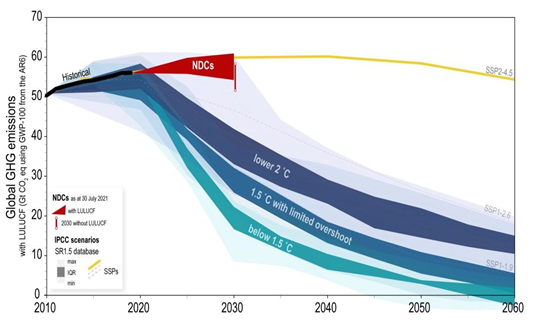
Going to the NDCs with their commitments (see also Fig 1), and additional pledges, the following can be mentioned:
- NDCs submitted and expected in July 2021 would result in 2.5-2.7 °C.
- All pledges, commitments, updated NDCs delivered at COP-26, (2021) would ideally result in 1.8-1.9 °C.
- Given the uncertainties in pledges and commitments and in updated NDCs, most publications assume that one is still heading for 1.9-2.5 °C.
- WMO (9 May 2022): there is a 43% chance that the 1.5 °C temperature mark will already be hit by 2027 …
- In conclusion, more ambition will be needed up to COP-27 in 2022 (and after).
Hence, net zero targets for 2050 are seen as more than urgent and ‘must’ deliver at short term. The net zero principle is based on four minimum criteria: a. pledge something fair by 2050; b. plan how to meet that pledge; c. proceed with the plan; and d. publish results. As mentioned in UN statements: “credible detailed plans to meet net zero are needed because long-term targets are near-pointless without interim plans and goals”.
Within this whole framework of policy, pledges, real, virtual and non-realizable offsets, one obvious observation is that NDCs (which will, in fact, include all industry, transport, building, cooling and heating sectors etc.) need to present the total picture how countries are planning (their) ways to net zero in 2050. It will be clear that RACHP is just an (important) part of this and will be subject to what is being ‘planned globally’. Before going to the specifics of the RACHP sector, many important net zero developments are given below.
IMPORTANT ISSUES RELATED TO NET ZERO
Where the development of net zero (and its consequences) as outlined in IPCC reports is important, it is thought to be necessary to give more details on the following:
- The current status of net zero developments, since the RACHP sector will be part of this spectrum.
- Offsetting technologies because they could have an impact (if realized during 2020-2050) in relation to the capacity that will need to be converted to renewables.
- The challenges that are still perceived as major, impacting short term developments of net zero plans.
- Recent statements and reports summarizing what can generally be expected on net zero developments.
As an overall observation upfront, one can state that there are two ways to approach the net zero challenge:
(1) the application of existing technologies together with a rapid development of many new (GHG mitigation) technologies, so that all current (consumption) trends can simply be continued, or
(2) a mix of existing and new technologies, combined with the consideration of a circular economy with limited use of all global resources combined with a number of behavior patterns. At this moment, it is quite difficult to conclude which ‘direction’ net zero ‘will go’.
Where it concerns the RACHP sector, one may say that any further developments following way (2) seem the most logical, since it concerns an existing technology to be optimized, together with adequate refrigerant choices – with proper considerations of renewables and a circularity approach toward production and consumption patterns allowing for the circular economy to become the main/ stream-lined/ dominant way.
- Decarbonization (or net zero) is actually related to a (total) reduction of CO2 and CH4 emissions (and is often also considered for carbon-based gases, e.g., PFCs, HFCs), however, it cannot be defined as a zero carbon (related emissions) society (since it would still involve burning ‘carbon’, such as biomass and wood, to be possibly balanced by planting new trees). Net zero in this respect means that any further carbon (CO2 and CH4 emission) activities can be offset by activities that capture possible CO2 (possibly also methane) that continues to be emitted, be it by nature or by technology-based processes.
- Ambition (as a definition) is used for the development of good plans that lead to the net zero carbon society, which is supposed to halt further emissions that contribute to climate change by 2050, leading to a maximum global temperature increase by 2100 of 1.5 °C. In a first instance, it concerns a large energy production via renewable sources, but that is not all. At this moment, one therefore sees plans that are a mix of direct emissions reductions, plus a continuation of emissions offsets by technological carbon capture plans to be developed, and the important offsets by balancing continuing emission e.g., by growing trees and biological mechanisms in the oceans to absorb carbon dioxide.
The challenges of net zero; some critical comments how society shall reach net zero
- In principle one cannot decarbonize society, where in fact virtually all processes that take place in nature are using carbon-based molecules. ”A ‘zero carbon future’ does not bode well, either for us humans, or for the planet”.. “net zero has become a target within itself rather than enabling to achieve the real target which is climate change mitigation and/or adaptation. [..] If you cannot measure it; if you cannot manage it!” (Arbon, 2021). “Before it was co-opted, the term “Net Zero” was used to describe balanced scenarios, not building up greenhouse gases, not a company or country, the whole planet.” (Foley, 2021a; 2021b; 2021c).
- Following an analysis, the design of the Paris Agreement (and the net zero efforts) led the participants (i.e., governments) to agree on a higher collective goal, and to make (more) ambitious individual pledges (via NDCs). The outcome of that analysis illustrates a problem inherent to climate change measures: Success or failure is only determined by whether the collective goal is achieved, regardless of how much any single country contributes. So, while countries are all but assured of a bad outcome if they don’t take action, they could be even worse off if they limit their own emissions sharply but others would not. “What they want is some kind of assurance that others will contribute”. (InsCliNews, 2021). One of the key shortcomings of ‘Paris’ is that it fails to address the ‘free-rider problem’, which stems from the fact that countries would enjoy benefits of global efforts to limit emissions regardless of their contributions, a very important aspect.
- It means that the Paris Agreement, which depends on collective action, does not include the kinds of incentives and penalties that would ensure that countries do their part as e.g., the Montreal Protocol does, via compliance. It would be an issue to be addressed urgently, also much related to the net zero approach.
- “The best offset is no offset at all. Instead, reduce emissions – especially in the big energy and agriculture sectors. Offsets should be used sparingly. Offsets that avoid or reduce emissions today are best, followed by those that use nature to remove carbon later. Offsets that rely on nascent carbon removal technology are the riskiest of all. They may be useful someday. But not today.” (Foley, 2021a).
Results anticipated
- “Serious climate commitments recognize [..] to bring emissions to zero, not “Net Zero”, as quickly as we can. We cannot achieve this with imaginary offsets, carbon trading schemes, or vague “pollute now, remove it later” promises.” (Foley, 2021a). “Better climate pledges would start with bold, long-term goals. But they would also have more immediate metrics. Cutting emissions to zero by 2050 may be an excellent long-term goal, but it should come with intermediate (e.g., cutting emissions in half by 2030) and short-term (e.g., cutting emissions by at least 7% per year) milestones. Moreover, every business should carefully audit and report their progress on climate goals along the way. Results should be reported as seriously as financial statements, with leaders taking real responsibility for them.” (Foley, 2021c).
- More and more governments try to come up with long-term vison plans. It sounds nice for the public-at-large, but the plans have no or very few consequences at the very short term. Short-term measures will always be weighted by politics against the electorate, so it has to be based on shared (educated) visions. A start now may be possible, but it will always be focusing on 2030-2050, outside what ‘must’ be done at very short term (within the political 4-5 years term) (see current gas policies that might change ‘net zero’ a lot).
In conclusion, the question is whether net zero is becoming a ‘half-truth’ if only 50-70% of all countries (based on emissions) would manage to achieve reductions recommended for 2030 and beyond. Many countries still have to convince communities, industries and the consumer society (different lifestyles) to go for good targets. Not the bad ones, with many off-setts, with greenwashing and loopholes, that lack a complete (international) picture of green financing. These issues will have to be resolved as soon as possible at both the policy, industry and consumer level, even when that resolution still seems to need many steps forward. “Unlike most races, the race to zero emissions will not have one winner. In this race we all win, or we all lose”. (NetZeroClim, 2021).
To repeat, the most important issue is: To avoid the worst climate impacts, total global greenhouse gas emissions will need to drop by about half by 2030 and reach net zero around mid-century (see Figure 1).
For the whole of this, whatever the policies will be regarding net zero for all emissive sectors, the RACHP sector should perform as ambitiously as possible. It will be dependent on all kinds of general trends where it concerns the production and use of renewables (electricity) in a global manner. It is worth mentioning that the RACHP sector has a major advantage and that is that it has been dealing with minimizing direct and indirect emissions of greenhouse gases (both CFCs, HCFCs, HFCs and CO2 from electricity) since the 1990s. That is the major starting point for considering how several net zero approaches would apply to RACHP in the following sections.
SEVERAL NET ZERO APPROACHES FOR RACHP
In relation to the RACHP sector that is (mainly) dependent on electricity supply (i.e., 20% of total global electricity supply at present), a more detailed approach will be needed. Achieving net zero emissions involves a number of actions in order to accomplish the target in a structured, and also in a somewhat holistic manner (the various approaches are not specified for any type of country, they are valid for RACHP in general). Four examples will be presented here, (1) one proposal by IMechE in the UK (IMeche, 2020) to go to net zero, (2) a proposal how to deal with net zero (or a net zero roadmap) by the UK Institute of Refrigeration (IOR, 2020), (3) a third one (called ‘Count on Cooling’) by the European Partnership for Energy and the Environment (EPEE, 2020), and a fourth one presented by the University of Birmingham specifically for the cold chain.
THE ENERGY HIERARCHY: MAKING FOR ‘NET ZERO’

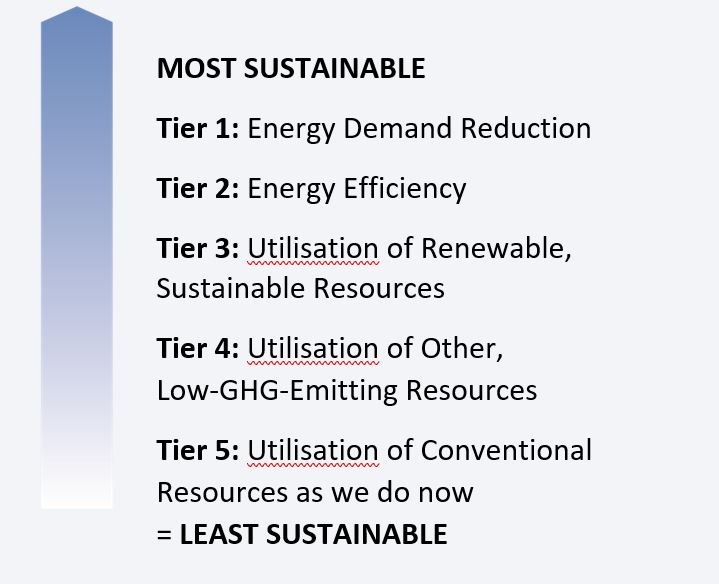
The IMechE Energy Hierarchy offers an effective framework to guide sustainable energy policy and decision-making. The proposal mentions that “By prioritizing the demand-side activities to reduce consumption and wastage and improve efficiency, the Hierarchy links closely to the principles of sustainable development and offers an integrated, easy to use, approach to energy system design and the management of energy demand and supply. Put simply, it offers a common-sense, cost-effective, sustainable energy policy that aims to reduce energy use before seeking to meet remaining demand by the cleanest means possible.” The Hierarchy concept is a simple one; it could have profound implications for energy strategy or policy.

The IOR (IOR, 2020) block schedule gives eight separate issues, without presenting a certain flow or sequence:
- System performance (maximize systems performance in operation, during lifetime, monitor)
- Using best technology (new technologies to be used, with guidance, expert knowledge)
- Balancing heating and cooling (if both are produced at the same time, make best use)
- Reducing the need for cooling (passive systems and low-tech solutions to be used first)
- Intelligent energy use (use energy wisely; this with renewables and grid transformation)
- Working together (communication within and outside the sector to make best decisions)
- People and skills (long term strategy to recruit, educate to have skilled people in the sector)
- Sustainability and more
In fact, rather than a random sequence as presented in Figure 2, the options can be grouped:
(1), (2), (3) and (4) all work towards reducing the environmental impact via energy demand reduction.
Even options (6, 7) are aiming at better performance (energy consumption) of systems (via good maintenance, low leakage etc.). Option 5, to use ‘energy intelligently’, is important for the renewables part, however, this actually falls outside a sort of an (IOR) RACHP scope or competence.
It is a given how electricity is supplied (direct, via storage), and which renewable electricity parts could be available for the sector (this is part of (8)).


The EPEE in its ‘Count On Cooling’ approach (EPEE, 2020) mentions the following necessary elements (Figure 3) towards achieving carbon neutrality or net zero carbon emissions, where there is a logic in presenting four elements, centred around investment costs, to enable an envisaged carbon neutrality.
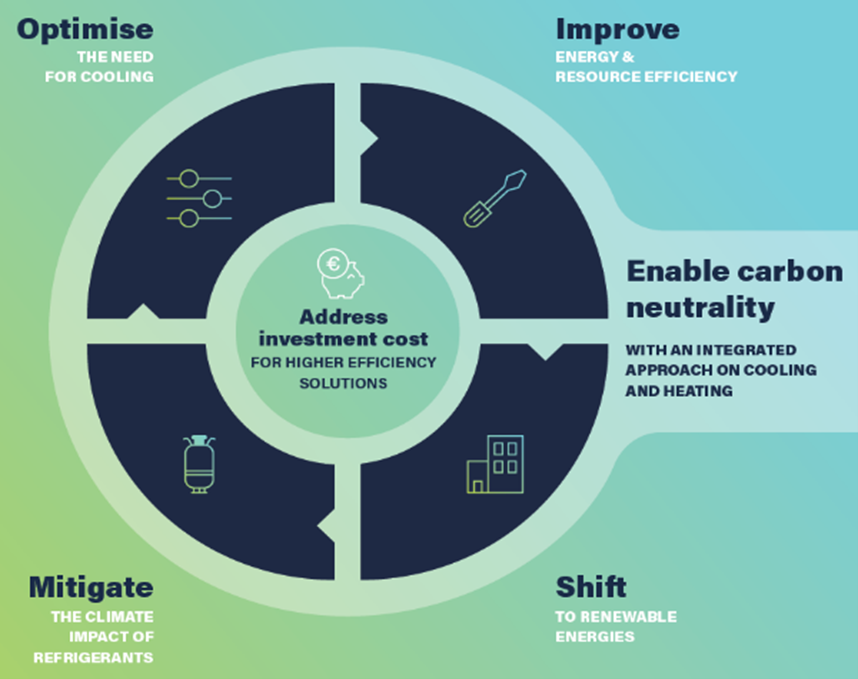
Where (a) is a climate impact, options (b) and (c) are directly related to the reduction of energy consumption, option (c) states ‘improve efficiencies’, an option that indirectly assumes that there are certain limits. The shift to renewable energies (d) is required, but may not belong in this sequence, and would actually fall outside the direct EPEE approach related to RACHP (comparable to the IOR (2020) approach).
On pathways to net zero for the cold chain, the presentation given in a Cold Chain webinar discussed the elements, see Figure 4 (IOR, 2021) below. It mentions a few specific elements:
(1) making use of natural, renewable, and waste energy resources, (2) using energy efficient technologies that avoid refrigerants with high GWP, and (3) taking a circular economy approach to design, manufacturing, deployment, operation and end of life decommissioning.
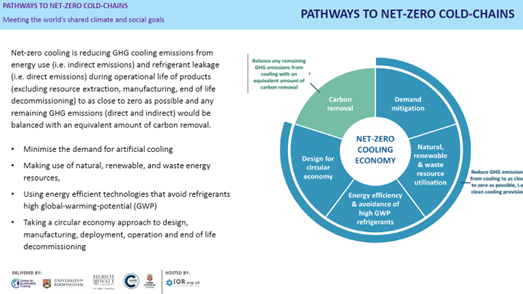
A list of measures can be composed based upon the various proposals:
- The refrigeration demand lowering issue is high on the lists in the IMechE, the IOR and the (IOR) Cold Chain proposals.
- The energy efficiency is clearly mentioned in the cold chain proposal, but it is implicitly provided in all other proposals.
- The refrigerant mitigation issue comes in via the EPEE approach, in some ways via the IOR building blocks and the IMechE Tiers, together with efficient technologies in the Cold Chain proposal. A choice for low GWP options such as ammonia, CO2, hydrocarbons and HFOs would be essential and a necessary commitment or approach, since direct energy efficiency impacts related to the refrigerant choice are small (McLinden, 2017; Kuijpers et al., 2019; Kuijpers et al., 2021). However, given the fact that refrigerant emission issues are minor in the total of net zero, it will not end up high in a priority list to be developed.
- The cost to reduce consumption (or maybe it also implies to reducing the need for capacity) is only presented in the EPEE approach; however, it is left to a wide interpretation in relation to its implication and/or its feasibility. EPEE presents investment costs for higher energy efficiency as a core issue, which brings in an extra parameter that cannot be precisely estimated. It implies that the higher investment costs are made, the higher the efficiency would become, which may only be true to some degree.
- Adequate planning for renewables so that they become a large (eventually the only) part of the electricity provided is mentioned in all proposals (together with waste energy resources in the Cold Chain proposal).
A priority list to be derived could then be as follows:
- Reduce the demand as much as possible via strategies to operate RACHP wisely in “its temperature environment” (building efficiency, installation practices, temperature settings etc.);
- Increase the (energy) efficiency of the RACHP operation via the best components, and also via the way how to seasonally operate the equipment, choose the right components to maximize the performance (efficiency) of refrigerants;
- Utilise all possible renewable (or at least carbon neutral) energy sources;
- Optimise costs, or appropriate consideration of investments to make elements I-III possible (this is then interlinked with all actions above, and asks for good systemic approaches).
Good practices, optimizing the efficiency during the lifetime of the equipment is not explicitly mentioned, but these would definitely need a very serious consideration (see also below).
The whole ‘complexity’ considering the separate issues to be looked at comes mainly down to reducing the demand via a large number of measures and increasing the efficiency, next, filling in the electricity demand via renewables in order to achieve net zero. However, the important issue is that one does not have a degree of freedom for these elements. It implies that the RACHP part needs to be prioritised where it involves reducing the demand and further increasing efficiency.
However, in a roadmap to net zero for RACHP, the application of renewables cannot be simply the remaining part for filling in the ‘net zero equation’, even when that part is of utmost importance. In summary, any good solution to the challenge of addressing net zero by 2050 is definitely very much related to how one can and will deal with the input of renewable (electricity) energy contributing to the total.
PATHWAYS FOR RACHP TO NET ZERO
Before going to the pathways for RACHP, one issue deserves mentioning. In decarbonizing society, many sectors will still have to find ways to cope with the decarbonizing, with using electrical energy in the best way possible (i.e., reducing demand etc.). This e.g., very much applies to electric vehicles, to make them lighter etc. (Nature, 2021b). The RACHP sector has a major advantage here. It is a sector, that, for the largest part, has always used electricity as the driver, prioritized climate related elements since the 1990s, i.e., was set to phase out high GWP chemicals, to increase efficiency, and to lower demand issues. It may therefore well be ranked high on the list to only use renewable electricity, for emission reductions, in a complete net zero infrastructure.
A number of issues need to be considered in planning specific pathways to net zero for RACHP following the priority list given above. In principle one should follow the reduction steps as indicated in the IPCC pathway for 1.5° C, i.e., a more or less 50% reduction by 2030 and a 75% reduction by 2040. Where the emissions from HFCs should be included, one also needs to bear in mind that the current situation in developed and developing countries is different; the considerations given here can therefore only be qualitative or overall quantitative ones.
Another issue is that fossil fuel operated heating systems in residential and commercial buildings need to be converted to electrically driven heat pumps over time. In new houses, heat pumps could be installed immediately, dependent on countries’ situations, financial measures as well as subsidies. A preliminary estimate is that the amount of electricity used in the total (20% globally in 2020, following business as usual) for the RACHP sector may easily increase by a factor of 2.5-3 due to the large number of heat pumps -and AC units- that will have to be added (note; this will be very country specific, it does not include the use of certain high temperature (industrial heat pumps)). However, the amount of electricity that is expected to be needed for all other uses is also expected to increase by at least a factor of 3-4 (it is yet unclear how much hydrogen as a source will be part of this). The future percentage of electricity needed for the RACHP sector in the “whole” is very difficult to determine at present, so what exactly will happen cannot be estimated. This implies that the supply of renewable electricity to the RACHP sector will need to be at least synchronised with the total amounts of renewable electricity that will (increasingly, or have to be) available for all uses. It is virtually impossible to even derive good (complete) estimates for the future at this moment.
During the period 2020-2030 (i.e., this decade) as many as possible measures need to be taken to (1) lower the RACHP demand and to (2) increase the efficiency of all RACHP equipment (i.e., the efficiency of both new and replacement equipment), aiming at 50% emission reductions (at least). One should mention here that the IOR has also recently published a paper with a large number of considerations for various sub-sectors (IOR, 2021b).
The following aspects will definitely need consideration:
- For the demand lowering one could mention increased (better) insulation of equipment and buildings, other (passive) ways and means to reduce the heating/cooling demand of equipment and buildings, and definitely user behaviour. Good practices are definitely a very important element here.
- For energy efficiency, it would also apply to continuously monitor equipment performance, since the efficiency will degrade the longer the system would be in operation without best maintenance. Pearson (2021) mentioned for cold storage equipment “The range from best practice to worst performance is a factor of 10 to one where the average line, obviously, is in the middle”. The existing equipment will therefore have a large potential for decreasing its demand, via a variety of measures.
- For energy efficiency, it applies to more integrated strategies to achieve higher seasonal performance, to a further increase of energy performance standards. This should be combined with innovative solutions for the operation of equipment together with low GWP refrigerants.
- During the 2020-2030 decade, an increasing amount of heat pumps for heating will be connected to the electricity grid, but it is difficult to estimate what the impact will be, since it is a new sub-sector to be added, which should perform at the highest possible (seasonal) efficiency.
- By the way, a good overview of a large number (wide variety) of measures, regulations, etc. that could possibly be applied is given in a report by SEforAll (2021).
However, the percentage reduction achievable will be very much dependent on all possibilities to increase the use of renewable energy (i.e., renewable capacities to be made available, as a result of a national energy strategy).
A major issue here is in how far the demand can be further lowered by restrictions to the amounts of new equipment to be installed, and other measures related to regulations that have so far only been considered in publications, but have not really been considered in national plans. It will be clear that there is a large potential.
- During the period 2030-2040, the demand lowering measures (building and equipment insulation, good practices, passive measures, and innovative approaches) need to continue, they should even be applied more strictly to lower the heating and cooling demand in existing buildings. An increasing amount of heat pumps for heating will have to be connected to the electricity grid. It is difficult to determine whether this will lead to a 75% reduction of CO2 emissions over that period, much will depend on national circumstances and the possibility to use an increasing amount of renewable electricity, wherever available.
- During the period 2020-2040, the emissions of high GWP substances (this applies to HFCs) will need to be reduced by at least 75% (which may be possible using the existing Kigali schedules). Negotiations on a strengthening of the Kigali schedules with the target of an HFC phase-out by 2050 may also be necessary in this period. This will imply (further) use of low GWP substances, including natural refrigerants and HFOs. In how far the near-term discussions on the disadvantages of HFOs (via addressing the issue of decomposition products and via the possible measures to ban PFAs via REACH) will lead to a limited use cannot be forecast at this moment (note: this should also be part of near future (inter)national policies). A virtual phase-out by 2050 with small HFC quantities allowed after 2050 might be possible. However, once a strategy to phase-out HFCs will have been established, it can be expected that a complete replacement (taking into account a 2050 phase-out) might even be realized around the year 2040 already (Kuijpers et al., 2021).
- During the period 2030-2050, all long-term demand reduction measures need to be completed. Furthermore, all high temperature (industrial) application actions so far operated on fossil energy need to be converted to a number of carbon neutral uses. Where this will not be possible, appropriate (acceptable) offsets for CO2 emissions need to be identified, but should already be accepted in the period 2030-2040.
Taking into consideration what has been emphasized in the RACHP sector during the last couple of years: the issue of the replacement of HFCs and the energy efficiency increase are considered the main issues. However, far more needs to be addressed “overall” now, in order to achieve the substantial CO2 (and non-CO2 gas) emission reductions needed.
CONCLUSIONS
- Climate change is caused by numerous ever-growing effects and impacts from an anthropogenic (earth) system that will cost time to stabilize, where the atmospheric stabilization will be a grand and also multi-faced, hence it is an immense operation. This will include a mix of nature restoration, human behavior and the application of good and new technologies at the right moment.
- The more CO2 and CH4 concentrations have increased, the counter measure that is now being considered is the decarbonization of society, to come to carbon neutrality (which is not ‘zero carbon’). The current terminology used for this is ‘net zero’, or the establishment of a ‘net zero society”. Net zero is a complex issue. Many entities are questioning the value of net zero and how society will be going to its net zero targets.
- It is still unknown what net zero will include or can include, and there are a number of technologies that still raise questions in how far they can contribute to a reduction of CO2 in the atmosphere without adverse effects. With all this being further investigated it is too early to make concrete conclusions in which direction it will all go. One may need to consider the saying ”less is more”, rather than just provide an uncertain future based on current, very preliminary estimates what various future technologies can accomplish.
- That all said, the question is whether society as a whole is capable to address the complexity of issues in an appropriate manner, where so many things are still solved via a sort of BAU scenario. A radical rethinking will be needed at very short term, by companies and governments, also related to the consumer level, to realize large reductions in emissions in less than 10 years – reductions that are unprecedented.
- The trend for 2030 so far is that countries (in their NDCs) are more or less stabilizing emissions, rather than to go to a 50% reduction as required in IPCC scenarios. The UNFCC mentioned: “However, elevated ambition and greater -and more immediate- outcomes are needed”.
- This has caused many warnings from institutions -and also from the UN Secretary General – that the required ambition is lacking and that 2024 will show a new peak in emissions rather than a reduction.
- For the RACHP sector it will be important to follow the pathways given in the IPCC (2018) report, i.e., to go to a 45-50% emission reduction by 2030, followed by further reductions after that. Four proposals containing the necessary elements for RACHP to go to net zero have been analyzed. In short, the priority list outlines (1) demand reduction, (2) increase of energy efficiency, (3) utilization of renewables and (4) optimization of costs or appropriate consideration of investments. Of course, installing renewable capacity remains crucial.
- Product energy efficiency increase, next to converting to low-GWP refrigerant options is often considered as the major mitigation possibility to cope with a large expected growth of the RACHP sector in developing countries. While it is undoubtedly an important aspect (also for making ‘cooling accessible to all’), the major issue now and in future will be related to managing the demand (i.e., reduction of capacity, cooling amounts). This will have to be realized via using energy efficiently, together with a change in structural elements, to be followed by solutions how to best cope with the necessary (and available) renewable energy supply. Additionally, it becomes a chain issue much related to systemic efficiency.
- An analysis for the emission pathways to 2050 for the RACHP sector has been made. This emphasises a large number of demand-lowering measures as well as energy efficiency increase measures for equipment in this decade, until 2030. In case that the RACHP demand could be minimized to the degree possible (while maximizing the energy efficiency of equipment), it is very likely that the RACHP sector could (with maximum efforts) achieve at least a 50% reduction in emissions by 2030, while taking into account any further growth.
- Within this framework, it needs to be mentioned that renewable energy supply cannot cover the global demand from unlimited growth in new (electrical etc.) equipment, since there are also definite limitations to the growth of installing renewable capacity (as well as other measures to reduce emissions), based on infrastructure elements as well as from a resource efficiency point of view and environmental concerns. It is very important for what is realizable by 2030 (starting now), but also by 2040 and beyond. The whole will also very much apply to the whole RACHP sector.
- The interlinkage between an HFC phase-down for RACHP applications — via low-GWP conversions and energy efficiency improvement and energy demand lowering exist. However, both are also separate issues to a substantial degree, as has been explained by many investigations. One shall be sensible that a lot of the HFC phase-down issues are already considered under the Montreal Protocol (but could still be in NDCs).
- The choice for low GWP refrigerants such as ammonia, CO2, HCs and some HFOs is an issue that enables ways and means towards environmentally responsible refrigerant use, while reducing energy consumption (even when mainly application related). Applying these refrigerants will result in further optimization possibilities, hence, they will play a big role towards net zero emissions. The use of HFOs versus others has not been considered here. The most important topic that remains is the overall achievement of a 50% reduction in total emissions by 2030 (or more), followed by further reductions towards 2050 to achieve net zero. One shall also be mindful of the proper safe handling, training requirements, standards and maintenance required for any technologies applied here.

Lambert Kuijpers
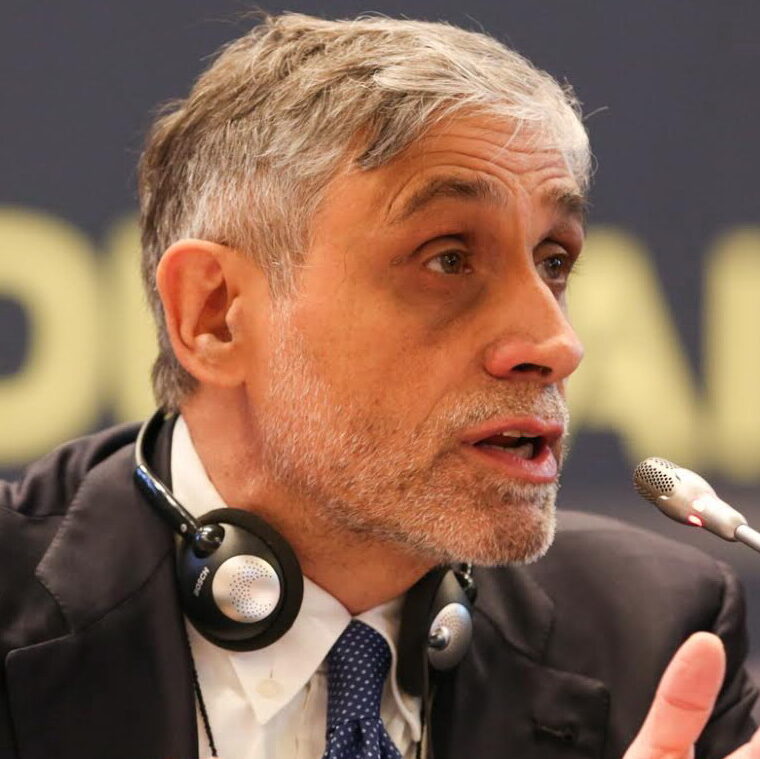
Fabio Polonara
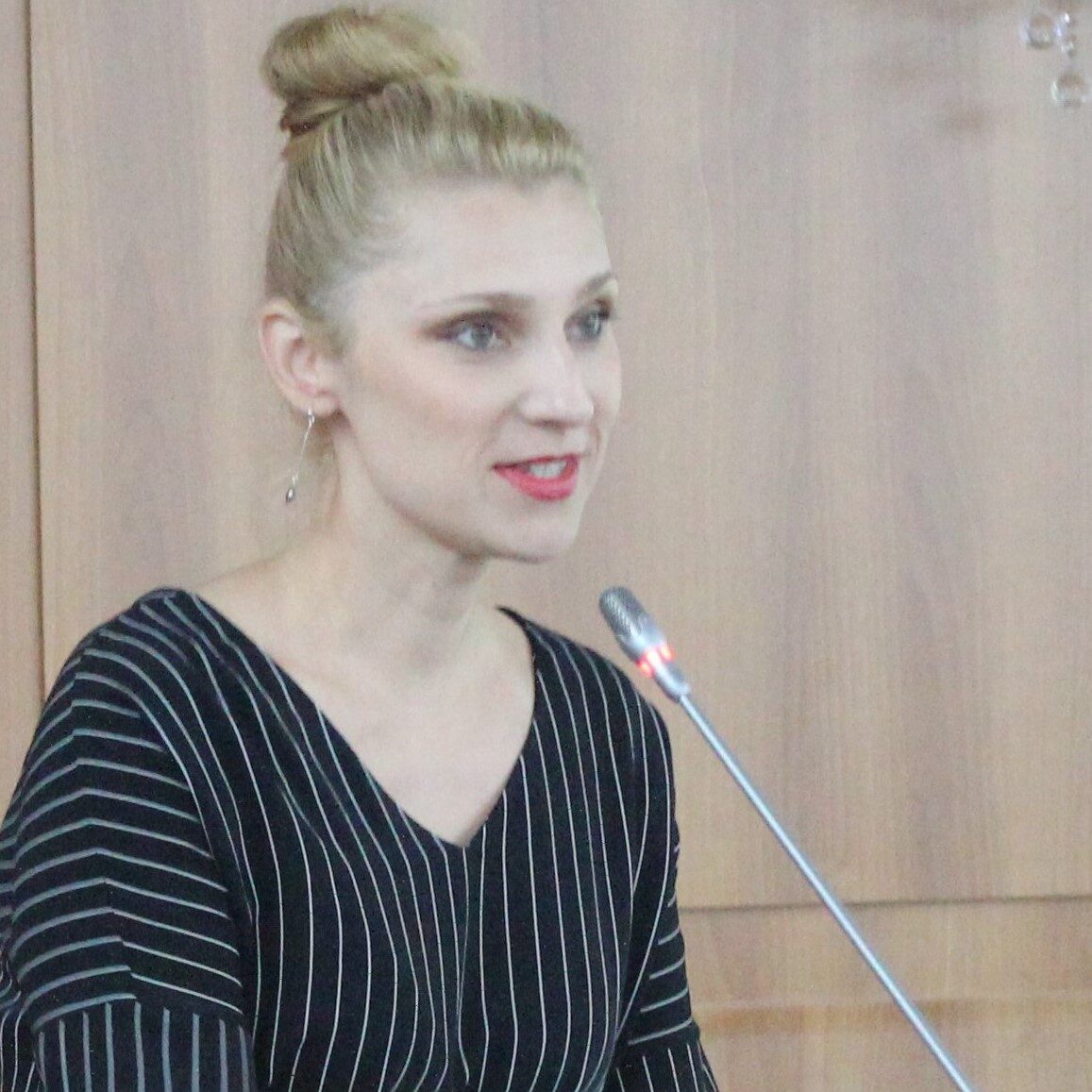
Natasha Kochova

Asbjorn Vonsild
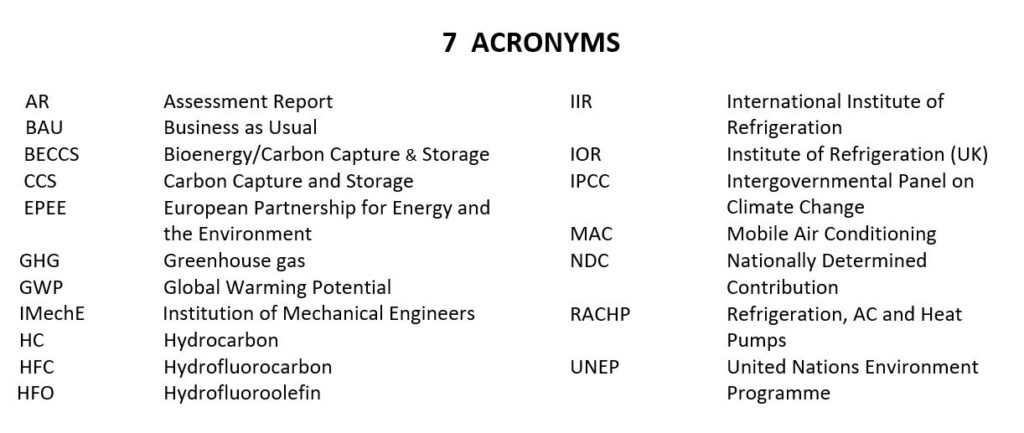
References
Arbon, 2021 Arbon, Ian M., eurammon Symposium, June 2021, The natural path to net zero. https://www.eurammon.com/images/eurammon/attachments/Symposium_2021/Keynote_eurammon-symposium-2021_Ian-Arbon_Engineered-Solutions_Is-decarbonization-enough-to-achieve-net-zero-by-2050.pdf
EPEE, 2020 EPEE, Count on Cooling, presented March 2020. http://countoncooling.eu/
Foley, 2021a J. Foley, February 2021. Carbon Offsets Should Make You a Little Nervous. ReGenFriends, https://www.regenfriends.com/post/carbon-offsets-should-make-you-a-little-nervous
Foley, 2021b J. Foley, June 2021. The World Needs Better Climate Pledges. https://globalecoguy.org/the-world-needs-better-climate-pledges-4c3d969790d3
Foley, 2021c J. Foley, June 2021. Why the world needs better pledges. Greenbiz Magazine. https://www.greenbiz.com/article/why-world-needs-better-climate-pledges
IMechE, 2020 Institution of Mechanical Engineers, June 2020. The Energy Hierarchy: a powerful tool for sustainability. https://www.imeche.org/news/news-article/the-energy-hierarchy-a-powerful-tool-for-sustainability
InsCliNews, 2021 Inside Climate News, July 2021. Why the Paris Climate Agreement Might be Doomed to Fail. https://insideclimatenews.org/news/28072021/pairs-agreement-success-failure/
IOR, 2020 https://ior.org.uk/ior-unveils-priorities-to-deliver-net-zero-cooling. Institute of Refrigeration, UK, 16 June 2020.
IOR, 2021a https://www.coldchainfederation.org.uk/wp-content/uploads/2021/04/PATHWAYS-TO-NET-ZERO-14-MAY.pdf
IOR, 2021b IOR, various authors. The Journey to Net Zero. October 2021.
IPCC, 2018 IPCC Special Report on Global Warming of 1.5 °C, 2018. For the SPM: https://www.ipcc.ch/sr15/chapter/spm/. See for chapters: https://www.ipcc.ch/sr15/chapter/chapter-X/ (X=1, 2, 3 etc.)
IPCC, 2021a IPCC, see Science alert, 25 June 2021. https://www.sciencealert.com/someone-leaked-the-next-ipcc-report-here-s-how-experts-are-reacting, See also IPCC Statement: https://www.ipcc.ch/site/assets/uploads/2021/08/202119ST.pdf
IPCC, 2021b IPCC Sixth Assessment Report, August 2021. AR6 Climate Change 2021: The Physical Science Basis, https://www.ipcc.ch/report/ar6/wg1/. Summary for policy makers: https://www.ipcc.ch/report/ar6/wg1/downloads/report/IPCC_AR6_WGI_SPM.pdf
IPCC, 2022 IPCC Sixth Assessment Report, April 2022. AR6 Climate Change 2022: Mitigation of Climate Change, https://www.ipcc.ch/report/ar6/wg3/
Kuijpers, 2019 Kuijpers, L., Kochova, N., Vonsild, A., 2019. Climate considerations for R/AC equipment operation: is the answer in energy efficiency? 8th IIR Conference on ammonia and CO2 technologies, Ohrid 2019, DOI: 10.18462/iir.
Kuijpers, 2021 Kuijpers, L., Kochova, N., Vonsild, A., 2021. Steps towards a low and a net zero emissions future, 9th IIR Conference on Ammonia and CO2 technologies, Ohrid 2021. DOI.
Kuijpers et al., 2021 Kuijpers, L., Kochova, N., Vonsild, A., Pathways to net zero: what decarbonization by 2050 means and related issues for RACHP, Paper II2.14, DKV Conference, Dresden (November 2021).
McLinden, 2017 McLinden, M., Steven Brown, J., Brignoli, R., Kazakov, A.F., Domanski, P.A., 2017. Limited options for low-global-warming-potential refrigerants, Nature Communications 8, 17 February 2017, see also McLinden, M., 2019. Thermodynamics of the New Refrigerants, 25th ICR Congress, 24 August 2019, also: McLinden. M., Kazakov, A.F., Steven Brown, J., Brignoli, R., Bell, I.H., Domanski, P.A., 2019. Options for Low-GWP Refrigerants in Small Air-conditioning Systems, IOR paper, UK, Nov 2019.
Meadows, 1972 Club of Rome, 1972 (Meadows, D., lead author). https://www.clubofrome.org/publication/the-limits-to-growth/
Nature, 2021 Nature, September 2021. Most fossil-fuel reserves must remain untapped to hit 1.5 °C warming goal. https://www.nature.com/articles/d41586-021-02444-3
Nature, 2021b Nature, October 2021. Make electric vehicle lighter to maximize climate and safety benefits https://www.nature.com/articles/d41586-021-02760-8
NetZeroClim, 2021 Net Zero Climate, 14 July 2021. https://netzeroclimate.org/getting-net-zero-right-a-tool-kit/
Pearson, 2021 A. Pearson. Optimising energy use in refrigeration systems. 9th IIR Conference on Ammonia and CO2 technologies, Ohrid 2021. DOI: 10.18462/iir.nh3-co2.2021.0001
SEforAll, 2021 SEforAll, Cooling for all. September 2021. “The Cooling Solutions Directory”. https://thisiscool.seforall.org/solutions
Skea, 2022. Skea, J., 2022. Statements at the IPCC WGIII Press release, 4 April 2022. https://www.ipcc.ch/2022/04/04/ipcc-ar6-wgiii-pressrelease/
UNEP, 2019 Cool Coalition comes together to save lives, energy and trillions for the global economy. 4 April 2019. https://www.unep.org/pt-br/node/24732.
UNEP, 2021 UNEP, 26 October 2021. The heat is on (Emissions gap). https://www.unep.org/resources
UNEP, 2022 UNEP, 2022. Executive Director Andersen, Statements made at the IPCC WGIII report press release. https://www.unep.org/news-and-stories/speech/half-measures-will-not-halve-emissions
UNFCCC, 2021a UNFCCC, September 2021, Nationally determined contributions under the Paris Agreement, Synthesis report by the secretariat, for COP-27, Glasgow, FCCC/PA/CMA/2021/8 (17 September, advance version)
UNFCCC, 2021b UNFCCC, July 2021, 2030 Breakthroughs report, Upgrading our systems together, A global challenge to accelerate sector breakthroughs for COP26 – and beyond, https://racetozero.unfccc.int/wp-content/uploads/2021/08/2020-Breakthroughs-Upgrading-our-sytems-together.pdf.
For info: all links to publications and websites have been checked on 20 May 2022.
